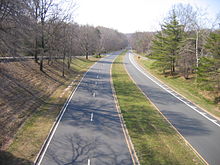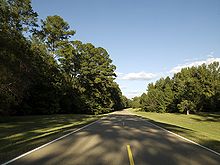Parkway

In the United States , the term parkway means :
- A street type
- A wide road that bans trucks and other heavy vehicles.
- A road through a park: A road that connects parks.
- A freeway-like road that runs over the grounds of a public park and heavy vehicles are therefore prohibited.
- A strip of land between a thoroughfare and its sidewalk or on the median of a thoroughfare.
Since the late 20th century, many places have added buses , taxis, and rental cars to their approved vehicle lists to encourage public transportation. With this change, the difference between Parkway and Freeways has been softened.
history
Many different types of streets have been referred to as a parkway over the years. The first parkways in America were laid out in the 19th century by Frederick Law Olmsted as separate roads for pedestrians, cyclists, horse riders and carriages. The most famous are the Eastern Parkway and the Ocean Parkway in Brooklyn . Streets like Commonwealth Avenue in Boston and Bidwell Parkway and Lincoln Parkway in Buffalo, New York have wide, separate carriageways and a large, landscaped median. These older parkways are often used as an entrance to a large city park, such as a parkway. B. Boston Common in Boston or Delaware Park in Buffalo. They are lined with houses. Some have separate lanes for express and city traffic, but this is not always the case.
During the early 20th century, the term was expanded to include motorways for excursions. The new parkways made it possible to access excursion destinations without interference from pedestrians or slow vehicles. These parkways increased the development of the outskirts, which ultimately limited their value as recreational areas.
Some of these parkways became local main roads or interstate highways, but they retained the parkway designation. These parkways were built primarily for through traffic and are commonly classified as freeway or toll highway .
Historically, the term "parkway" was often associated with a road with a naturalistic or well-tended, landscaped median, the surrounding areas of which were intended to seduce a leisurely driving style, free from commerce and advertising, even if the route led through populated areas. For this reason, it was also closed to commercial traffic. The parkway system was a forerunner to highway systems such as B. the German Autobahn and the American Interstate Highways.
The beginnings: New York City

The term “parkway” as a type of street was coined by the planners of New York's Central Park, Calvert Vaux and Frederick Law Olmsted , as a connecting street between the city center and the parks in the suburbs. The Eastern Parkway and the Ocean Parkway were built during this time. A short time later, similar parkways were created in and around Boston as part of an extensive park and street system. At the beginning of the 20th century, parkways were built in the area of New York City , which in terms of appearance and equipment came very close to the later freeways. Work on the Bronx River Parkway began in 1907, and that on Long Island Motor Parkway (also known as Vanderbilt Parkway) began in 1906. In the 1920s, the parkway system around New York City was established under the leadership of Robert Moses , President of Long Island State Park Commission, greatly expanded. Moses saw the parkways as a good way to give the populations of the crowded cities access to the undeveloped areas.
One of the most famous parkways in the New York Area is Merritt Parkway in Fairfield County, Connecticut , which opened in the 1930s. As this road runs through the forests of South Connecticut, it is an example of the parkway aesthetic, each bridge on the parkway is unique and highlights the beauty of that parkway. Another example in New York City is Sprain Brook Parkway, which not only takes travelers north out of the Bronx. It turns into the Taconic State Parkway and connects the metropolitan area with Albany in the state of New York. The Saw Mill River Parkway connects Yonkers and the Bronx , where it merges into Henry Hudson Parkway .
United States
In the early 20th century, landscape architect George Kessler designed extensive parkway systems for Kansas City, Missouri , Memphis, Tennessee, and other cities.
In the 1930s, the federal government adopted the concept of the parkway and built several scenic roads called the National Parkway for excursions. These two-lane parkways typically require relatively low speeds. These National Parkways are operated by the National Park Service . Examples are the partially from the Civilian Conservation Corps built the Blue Ridge Parkway / Skyline Drive in North Carolina and Virginia, the Natchez Trace Parkway in Mississippi, Alabama and Tennessee and the Colonial Parkway in the east "Historic Triangle" in Virginia. A number of other parkways were planned but not built during this time. The George Washington Memorial Parkway and the Clara Barton Parkway , along the Potomac River near Washington, DC , also date from this period , which are more of the older form and are now arterial roads for commuters to and from Washington.
Parkways in modern times
In Kentucky , parkways are toll highways. Nine parkways were built in the 1960s and 1970s. Kentucky law requires that parkways be converted to freeways if construction costs are covered by toll revenues. All nine streets have been freeways since 2006, but have kept the Parkway designation.
The Arroyo Seco Parkway from Pasadena to Los Angeles, dating from 1940, became the first segment of the great Southern California freeway system. It's now called the Pasadena Freeway and is part of Interstate 110 .
In the New York metropolitan area , parkways are usually, but not always, freeways for non-commercial traffic, and trucks and articulated trucks are not allowed to use these streets.
In New Jersey , the Garden State Parkway north of New Jersey State Route 18 is also reserved for non-commercial traffic. Even so, it is the busiest toll road in the United States. It connects the northeastern New Jersey metropolitan area with the surrounding area, including Atlantic City .
In the Pittsburgh area , the two major interstates are informally referred to as parkways. Parkway East, (actually Penn-Lincoln Parkway), officially Interstate 376 , connects downtown Pittsburgh with Monroeville . Parkway West, officially Interstate 376 and US Highway 22/30, lead from downtown to Pittsburgh International Airport . Parkway North, officially Interstate 279 , connects Pittsburgh with Franklin Park .
In Minneapolis , the Grand Rounds Scenic Byway is 50 miles of parkway roads. These are not highways as they have a speed limit of 25 miles per hour and there are pedestrian crossings and intersections.
In Canada
In Canada, too, some streets are called parkways. Some of these streets in the capital region are administered by the National Capital Commission and have usage restrictions, similar to the US. Other roads with this designation are regular expressways or motorways, or they open up national parks .
- Colonel By Drive ( Ottawa )
- Prince of Wales Drive (Ottawa)
- Conestoga Parkway ( Kitchener )
- Don Valley Parkway in Toronto
- Hanlon Parkway in Guelph
- Icefields Parkway in Alberta
- Mount Seymour Parkway
- Niagara Parkway
- Ojibway Parkway
- Macdonald Parkway (Ottawa)
- Queen Elizabeth Driveway
- Thousand Islands Parkway
See also
Web links
Individual evidence
- ↑ a b c d "parkway." Webster's Third New International Dictionary, Unabridged. Merriam-Webster, 2002. http://unabridged.merriam-webster.com/ (Apr. 14, 2007).
- ^ Parkway. Archived from the original on October 9, 2012 ; accessed on March 4, 2017 (English).
- ^ Information Center: About the Grand Rounds. Archived from the original on February 14, 2015 ; Retrieved December 18, 2007 (English).
- ^ Second Ward, Minneapolis: Traffic Calming Event. Retrieved December 18, 2007 .

